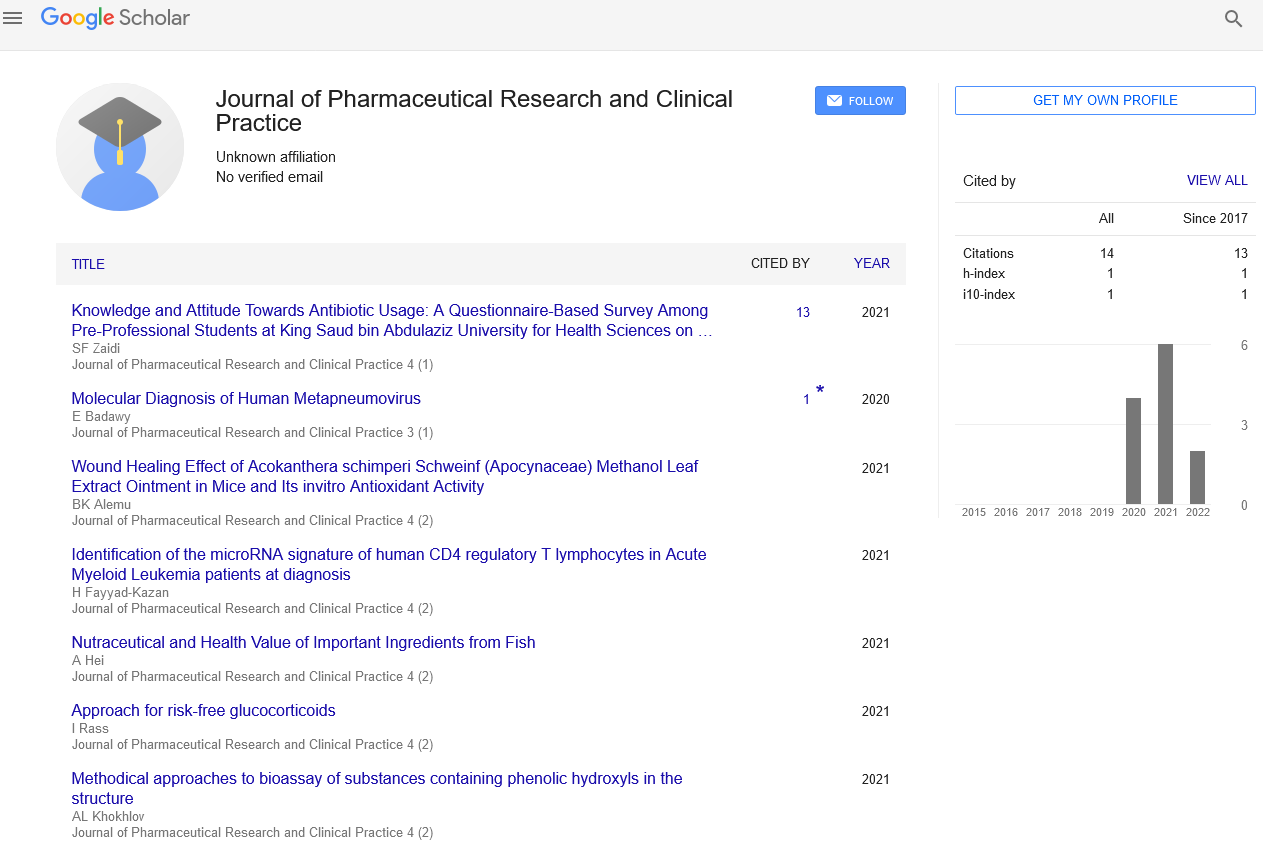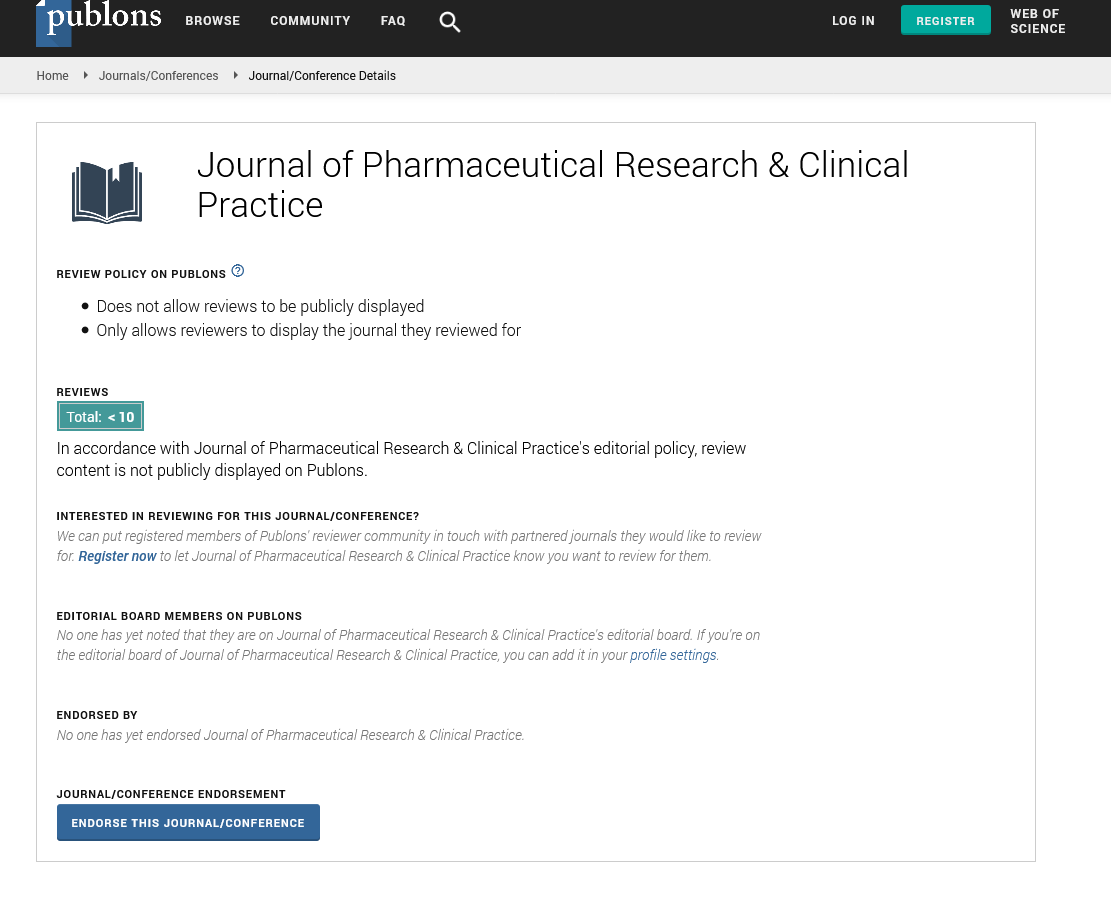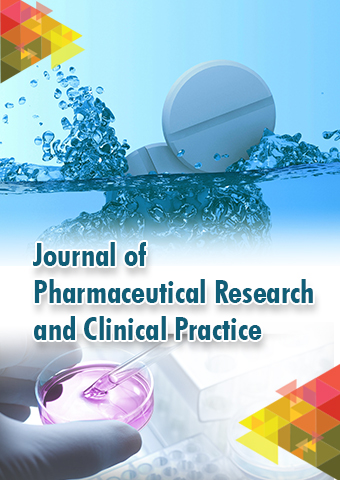Review Article - Journal of Pharmaceutical Research and Clinical Practice (2023) Volume 6, Issue 2
A Review on pharmaceutical and biomedical applications
Cristina Stoicescu*
Department of pharmaceutics, University of Oradea, Romania
Department of pharmaceutics, University of Oradea, Romania
E-mail: criststo@gmail.com
Received: 01-Apr-2023, Manuscript No. jprcp-23-95928; Editor assigned: 03-Apr-2023, PreQC No. jprcp-23- 95928(PQ); Reviewed: 17-Apr-2023, QC No. jprcp-23-95928; Revised: 24-Apr-2023, Manuscript No. jprcp-23-95928 (R); Published: 30-Apr-2023; DOI: 10.37532/ jprcp.2023.6(2).43-45
Abstract
The difficulty of treating damaged skin with conventional treatments and the rising incidence of skin diseases have prompted the creation of novel drug delivery systems for topical drug administration. Improved drug delivery features, such as controlled drug release, increased drug skin permeation and retention, and decreased systemic adverse effects, enable drug delivery systems to achieve these outcomes. For the treatment of skin conditions, natural polymers have proven to be useful excipients for incorporation into hybrid systems (nanocarriers dispersed in a semisolid base). Natural polymers have intrinsic bioactive properties that greatly enhance their applicability in drug delivery systems. These properties include being biocompatible, biodegradable, economical, easily available, and based on renewable resources. Chitosan, alginate, agarose, starch, hyaluronic acid, silk fibroin, collagen, and gelatin are just a few examples. These polymers also play a crucial role in the preparation of semisolid bases for cutaneous application, which improve the viscosity of formulations and, as a result, provide a suitable topical application for the management of skin diseases. Additionally, they play a crucial role in the preparation of polymeric nanoparticles, which increase skin penetration.
Keywords
Natural polymer •Nanotechnology •Topical drug administration
Introduction
Compared to systemic administration, topical application of active agents to the skin has numerous advantages for the management of various skin diseases and injuries. The controlled active agent release, targeted skin drug delivery, mitigation of off-target effects, smaller drug quantity needed to achieve the desired effect, avoidance of blood oscillation drug levels, decrease of the hepatic first-pass effect (which increases drug bioavailability), and good compliance by patients due to eliminating frequent dosing are some of these advantages. Other advantages include easy and convenient usage, absence or minimal pain, controlled active agent release, targeted skin drug delivery, and mitigation of off-target effects [1-3]. However, the difficulty of active agents penetrating the various skin layers due to the excellent barrier properties of the stratum corneum and tight junctions makes skin administration of active agents a technological challenge mitigates these benefits. As a result, there is a growing demand for novel formulations and methods that can successfully penetrate the skin strata. Particularly for topical therapy, nanoscale systems for the delivery of active agents have sparked a lot of interest. The factors that affect a molecule’s ability to be absorbed by a substance determine how effective topical products are.
The field of nanotechnology is currently exploding in the pharmaceutical and medical industries. Nanosystems’ special qualities, like their little size (1 nm-1000 nm) takes into consideration a higher contact surface with body tissues and permits these frameworks to enter the skin or mucous layers all the more effectively when controlled orally [4]. The skin penetrates and permeates primarily through the intracellular and intercellular transepidermal routes; however, the transappendageal route is also an effective penetration pathway and can serve as a reservoir for active agents that are applied to the skin. In general, it has relevant and disruptive physical, chemical, electrical, and optical properties that permit its use in a variety of fields.
In recent years, the clinical applications of nanotechnology have grown not only in the medical field but also in the diagnosis, prevention, and treatment of a variety of diseases, particularly at the skin level. This is because nanotechnology has made it easier and made it possible to get around some skin drug delivery barriers. For skin illnesses, effective organization has become more favoured in light of the fact that it beats the impediments of oral and parenteral organization and works nearer to the objective [5-7]. Additionally, this method of administration is non-invasive, simple, and free of first-pass effects, and increases patient compliance. The stratum corneum, on the other hand, restricts drug absorption, which reduces the therapeutic effect. Because of their ability to control the release of active agents and increase their retention in the epidermis, and the application of Nanoformulations for topical administration has received particular attention in this regard. Specifically, normal polymers definitely stand out of established researchers for being reasonable for the readiness of nanocarriers or semisolid bases (e.g., hydrogels). They can be incorporated either into the nanocarrier or the semisolid base of hybrid systems (nanocarriers dispersed in a semisolid base). Due to its ability to cross the stratum corneum barrier, these biopolymers can also be used to treat dermal conditions with microneedles [8]. These microneedles can provide this biopolymer with more effective therapeutic action on the skin. The assembling cycles of this kind of Nanosystems are generally founded on customary techniques for assembling nanoparticles, like ionic gelation, ionic cross-connecting, centrifugation, and expulsion.
Metals, ceramics, polymers, and composites are the four main chemical categories for biomaterials. Metals like titanium, stainless steel, silver, gold, and cobalt-chromium, as well as their alloys, are mostly used for bearing loads. Examples of loadbearing applications include hard tissue fixation devices like dental implants, hip and knee replacements, and bone plates and pins. Stents and heart valves for cardiovascular applications and orthodontic arches for maxillofacial applications are two examples of more active roles that some metallic alloys can still play. Ceramics, such as calcium phosphates, porcelain, bioactive glasses, alumina, and carbons, are very biocompatible and inert materials that are resistant to compression. Because of their high hardness and resistance to compression, ceramics are frequently utilized as surface coatings to cover orthopedic and dental implants to reduce wear. Composites, like polyvinyl chloride-glass fillers and hydroxyapatite-collagen, are solids that combine various materials (like metals, ceramics, or polymers) in a synergistic way to improve their mechanical properties (in comparison to those of homogeneous biomaterials). As a result, dental cements and restorations can benefit from their use.
A polymer is a macromolecule (huge particle) comprised of rehashing underlying units, which are commonly connected by covalent synthetic bonds. There are manufactured and regular polymers, yet the last option stand out for a large number of uses [9-10]. The petrochemical industry is the primary source of synthetic polymers, which are made from non-renewable resources. There are a few issues related with petrol determined polymers, in particular developing financial and ecological worries connected with garbage removal, the consciousness of its finitude, taking off oil costs, and the vast majority of them are non-biodegradable in nature .The majority of biodegradable polymers are obtained from renewable sources, overcoming issues related to the scarcity of petroleum resources and their environmental residues, even though both synthetic and natural polymers can be biodegradable.
Conclusion
The search for new DDS that can deliver drugs to the skin effectively has been sparked by the growing number of skin diseases and the ineffectiveness of conventional treatments. Due to their known advantages over systemic administration, such as their non-invasiveness and ease of administration, topical administration of active agents is one of the preferred methods. However, few molecules are able to enter or pass through the skin because it is an excellent barrier against the entry of external agents. Nano technological approaches have been permitting the embodiment of medications, diminishing their secondary effects on the skin surface, as well as adding to delayed and designated drug discharge on the skin.
Declaration of Competing Interest
The authors declare that they have no known competing interests.
Acknowledgment
None
References
- Namdaroğlu S, Tekgündüz E, Bozdağ SCet al.Microbial Contamination ofHematopoieticProgenitor Cell Products. Transfus Apher Sci.48, 403–406 (2013).
- Wang S, Sun J, Chen Ket al.Perspectives of Tumor-Infiltrating Lymphocyte Treatment in Solid Tumors. BMC Med.19, 140-146 (2021).
- Eshhar Z, Waks T, Gross Get al.Specific Activation and Targeting of Cytotoxic Lymphocytes through Chimeric Single Chains Consisting of Antibody-Binding Domains and the Gamma or Zeta Subunits of the Immunoglobulin and T-Cell Receptors. Proc Natl Acad Sci.90, 720–724(1993).
- Harwood CR.Bacillus subtilis and its relatives: Molecular biological and industrial workhorses.Trends Biotechnol. 10, 247-252 (1992).
- Young EJ.Engineering the Bacterial Microcompartment Domain for Molecular Scaffolding Applications.Front Microbiol. 8, 1441-1445(2017).
- Liu Y.Pathway engineering of Bacillus subtilis formicrobialproduction of N-acetylglucosamine.Metab Eng. 19, 107–115 (2013).
- Panahi R.Auto-inducible expression system based on the SigB-dependent ohrB promoter in Bacillus subtilis. Mol Biol.48, 852–857(2014).
- Feng Y.Enhanced extracellular production of L-asparaginase from Bacillus subtilis 168 by B. subtilis WB600 through a combined strategy.Appl Microbiol Biotechnol. 101, 1509–1520 (2017).
- Schallmey M, Singh A, Ward OP.Developments in the use of Bacillusspeciesfor industrial production.Can J Microbiol.50, 1–17(2004).
- Perkins J.Genetic engineering of Bacillus subtilis for the commercial production of riboflavin.J Ind Microbiol Biotechnol. 22, 8–18(1999).
Indexed at,Google Scholar ,Crossref
Indexed at,Google Scholar ,Crossref
Indexed at,Google Scholar ,Crossref
Indexed at,Google Scholar ,Crossref
Indexed at,Google Scholar ,Crossref
Indexed at,Google Scholar ,Crossref
Indexed at,Google Scholar ,Crossref
Indexed at,Google Scholar ,Crossref
Indexed at, Google Scholar , Crossref


